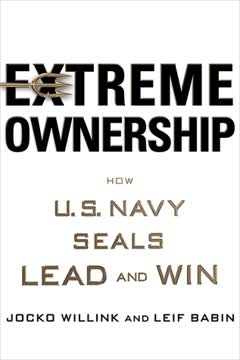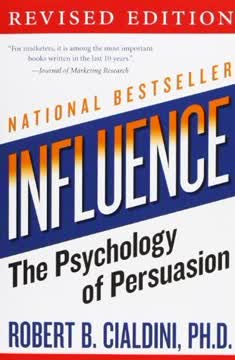Key Takeaways
1. Noble Purpose Drives Sales Performance and Engagement
"Salespeople who sold with Noble Purpose—who truly wanted to make a difference to customers—consistently outsold the salespeople who were focused on sales goals and money."
Purpose outperforms profit focus. Research shows that salespeople driven by a desire to improve customers' lives consistently outperform those focused solely on hitting quotas and making money. This counterintuitive approach leads to:
- Higher sales revenue and larger deals
- Increased customer loyalty and retention
- Greater job satisfaction and employee engagement
Purpose-driven salespeople are more resilient, ask better questions, and create stronger connections with customers. They're able to articulate value more effectively and are less likely to resort to discounting. By aligning their efforts with a higher goal, they tap into intrinsic motivation that sustains performance over the long term.
2. Reframe Sales from Profit-Centric to Customer Impact-Focused
"Profit is not the purpose of a business but rather the test of its validity."
Shift focus to customer impact. Traditional sales approaches often prioritize internal metrics over customer outcomes. This leads to:
- Short-term thinking and transactional relationships
- Commoditization and price-based competition
- Decreased innovation and strategic thinking
By reframing sales around the impact on customers' lives and businesses, organizations can:
- Create sustainable competitive advantage
- Drive innovation and long-term growth
- Build deeper, more meaningful customer relationships
- Increase employee engagement and retention
This shift requires aligning the entire organization around a customer-centric purpose, from leadership messaging to performance metrics and incentives.
3. Craft and Communicate Your Noble Sales Purpose (NSP)
"Your NSP should articulate both your aim and your lane: the impact you aspire to have, and where you intend to do it."
Define your unique impact. A well-crafted Noble Sales Purpose (NSP) clearly articulates how your organization makes a difference to customers. To create an effective NSP:
-
Answer three key questions:
- How do you make a difference to customers?
- How are you different from competitors?
- On your best day, what do you love about your job?
-
Keep it concise, specific, and action-oriented
-
Ensure it's both aspirational and achievable
Examples of effective NSPs:
- "We help small businesses be more successful" (CMIT Solutions)
- "We fuel prosperity" (Atlantic Capital Bank)
- "We redefine our industry" (Supportworks)
Communicate your NSP consistently across all touchpoints, from sales interactions to marketing materials and internal communications.
4. Use Customer Intelligence to Activate Your NSP
"You can't make a difference to your customers if you don't understand them."
Deepen customer understanding. To effectively activate your NSP, salespeople need to gather robust customer intelligence in five key areas:
- Customer environment
- Customer goals
- Customer challenges
- What success looks like for the customer
- What lack of success looks like for the customer
By focusing on these areas, salespeople can:
- Ask more insightful questions
- Uncover hidden opportunities
- Create more compelling proposals and presentations
- Establish stronger emotional connections with customers
Train your team to consistently gather and utilize this intelligence, integrating it into your CRM and sales processes to drive more meaningful customer interactions.
5. Transform Sales Interactions with Purpose-Driven Techniques
"The questions you ask your salespeople become the questions they ask their customers."
Elevate sales conversations. Purpose-driven sales techniques create more engaging and differentiated customer interactions. Key approaches include:
-
"You-Me-You" call openings:
- Start with a topic of interest to the customer
- Briefly state your expertise
- Ask an insightful question to engage the customer
-
Purpose-driven presentations and proposals:
- Summarize customer intelligence
- Clearly state what success looks like for the client
- Describe how the customer will be different after working with you
- Provide proof through customer impact stories
-
Noble Purpose negotiations:
- Focus on creating mutual value
- Articulate the long-term impact of your solution
- Stand firm on your differentiated value proposition
By consistently using these techniques, salespeople can create more meaningful conversations that lead to larger deals and stronger customer relationships.
6. Build a Culture of True Believers Through Purpose
"The internal conversation will always become the external conversation."
Create a purpose-driven culture. To build a tribe of true believers, infuse your Noble Purpose into every aspect of your organization:
- Language: Develop a unique lexicon that reinforces your purpose
- Artifacts: Display visual reminders of your impact on customers
- Beliefs: Clearly articulate and reinforce your core values
- Daily practices: Align routines and rituals with your purpose
- Metrics: Measure and celebrate customer impact alongside financial results
Purpose-driven culture-building activities:
- Start meetings with customer impact stories
- Create a "day in the life" of your customer experience for employees
- Recognize and reward purpose-driven behaviors
- Use your NSP as a decision-making filter
By consistently reinforcing your purpose, you create a shared belief system that drives engagement, innovation, and differentiation.
7. Incentivize and Recruit for Noble Purpose
"If you want to create a differentiated sales team, you have to point them toward a different target."
Align incentives with impact. Traditional sales incentives often focus solely on short-term financial metrics. To drive purpose-driven performance:
- Reward customer results and long-term impact
- Recognize interim behaviors that align with your NSP
- Celebrate customer retention and relationship-building
- Create incremental promotions and growth opportunities
- Use public recognition to reinforce purpose-driven actions
In recruiting, lead with your Noble Purpose to attract like-minded individuals:
- Craft job postings that emphasize making a difference
- Use purpose-focused interview questions to assess alignment
- Create an onboarding experience that reinforces your NSP
By incentivizing and recruiting for purpose, you create a self-reinforcing cycle of engagement and performance.
8. Overcome Fear and Resistance to Purpose-Driven Sales
"Fear makes you frantic. You want salespeople who are focused."
Address fear and skepticism. Implementing a purpose-driven approach often faces resistance. Common challenges include:
- Fear of change and uncertainty
- Skepticism about the financial impact
- Resistance from traditionally-minded leaders
To overcome these obstacles:
- Lead with the financial case for purpose
- Share concrete examples of success stories
- Start with early adopters and build momentum
- Use customer impact stories to build emotional engagement
- Provide clear frameworks and tools for implementation
Remember that purpose is not about eliminating financial goals, but rather providing a more powerful way to achieve them. By addressing fears and demonstrating results, you can build buy-in across the organization.
9. Align Technology and Training with Your NSP
"Your technology should be humanizing your customers, not the opposite."
Purpose-driven systems and skills. Ensure your sales technology and training reinforce your Noble Purpose:
CRM and sales tools:
- Capture and prominently display customer impact information
- Use prompts and fields that reinforce purpose-driven behaviors
- Share customer stories and success metrics through internal communication channels
Training approaches:
- Use experiential, self-discovery learning methods
- Practice purpose-driven techniques in realistic scenarios
- Reinforce the "why" behind new skills and behaviors
By aligning your systems and skill development with your NSP, you create a consistent ecosystem that supports purpose-driven sales.
10. Sustain Noble Purpose Across the Organization
"Noble Purpose does not eliminate sales targets; it puts them in context."
Embed purpose organization-wide. To create lasting impact, Noble Purpose must extend beyond the sales team:
- Leadership: Use the "Big Six CEO Moments of Purpose" to reinforce NSP
- Finance: Frame financial discussions around customer impact
- Marketing: Create tools and messaging that activate purpose in sales interactions
- Product Development: Use customer goals to drive innovation
- HR: Integrate purpose into hiring, onboarding, and development processes
- Operations: Align processes and metrics with customer impact
Use the Six-P model (Purpose, Profit, Process, Products, Promotion, People) to ensure balance and integration across functions. By embedding purpose throughout the organization, you create a powerful, differentiated culture that drives sustainable growth and engagement.
Last updated:
FAQ
1. What is Selling with Noble Purpose by Lisa Earle McLeod about?
- Core concept: The book centers on the idea that sales success is driven by having a Noble Sales Purpose (NSP)—focusing on making a meaningful difference in customers’ lives, not just closing deals or hitting quotas.
- Transforming sales: It reframes sales from a transactional activity to a purpose-driven, noble profession, elevating the role of salespeople.
- Organizational impact: The book also explores how NSP can transform company culture, employee engagement, and long-term business results.
- Practical framework: Readers are given actionable steps to discover, articulate, and activate NSP within their teams and organizations.
2. Why should I read Selling with Noble Purpose by Lisa Earle McLeod?
- Reframes the sales mindset: The book offers a fresh, research-backed perspective that restores meaning and nobility to the sales profession.
- Proven results: It draws on real-world case studies and over a decade of research showing that NSP-driven teams consistently outperform quota-focused peers.
- Actionable advice: Readers receive practical tools, coaching techniques, and examples to implement NSP immediately, improving both sales performance and morale.
- Addresses modern challenges: The book is highly relevant for today’s business landscape, where customers and employees expect more than transactional relationships.
3. What are the key takeaways from Selling with Noble Purpose by Lisa Earle McLeod?
- Purpose over profit: Sales teams focused on customer impact outperform those driven solely by financial targets.
- NSP as a strategic driver: A clear, customer-focused purpose aligns teams, drives engagement, and fosters innovation.
- Leadership’s critical role: Leaders must champion NSP, embed it in culture, and use it to guide coaching, training, and recognition.
- Stories and culture: Sharing customer impact stories and celebrating purpose-driven wins are essential for making NSP stick.
4. What is a Noble Sales Purpose (NSP) according to Lisa Earle McLeod, and how is it different from a mission statement or tagline?
- NSP definition: NSP is a concise statement about how your sales organization makes a meaningful difference in customers’ lives or businesses.
- Not a tagline: Unlike a slogan or marketing phrase, NSP is a strategic framework that guides every decision and action within the sales organization.
- Customer impact focus: NSP centers on the positive change you create for customers, not on products, features, or internal goals.
- Examples: Statements like “We help small businesses be more successful” illustrate NSP’s focus on customer outcomes.
5. How do you craft and claim your Noble Sales Purpose (NSP) using Lisa Earle McLeod’s method?
- Three discovery questions: Start by answering: 1) How do you make a difference to your customers? 2) How are you different from competitors? 3) On your best day, what do you love about your job?
- Concise statement structure: Use a simple format: “We [verb] [customer impact],” making it specific, actionable, and emotionally engaging.
- Aspirational yet concrete: Your NSP should inspire your team while clearly communicating your unique value to customers.
- Avoid clutter: Keep the statement clear and compelling, resisting the urge to add unnecessary qualifiers.
6. How does having a Noble Sales Purpose (NSP) change the mindset, brain, and behavior of salespeople?
- Engages higher brain functions: Focusing on making a difference activates the frontal lobe, enhancing empathy, problem-solving, and planning.
- Fulfills core needs: NSP addresses the human needs for belonging and significance, helping salespeople feel their work matters.
- Self-reinforcing motivation: Top performers naturally develop NSP as they see the impact of their work, sustaining effort beyond financial incentives.
- Improves customer engagement: NSP-driven salespeople ask better questions, gather richer insights, and build stronger customer relationships.
7. Why does Selling with Noble Purpose by Lisa Earle McLeod argue that profit is not a purpose?
- Profit as a result: The book emphasizes that profit is a test of business validity, not the reason for existence.
- Short-term risks: Overemphasizing profit leads to short-term thinking and increases the risk of ethical lapses.
- Balanced model: Effective organizations balance profit with process, products, promotion, and people, all centered around customer impact (NSP).
- Case studies: Examples like Wells Fargo’s scandal show the dangers of profit obsession, while NSP-driven companies achieve sustainable growth.
8. What is the difference between passion and purpose in sales, according to Lisa Earle McLeod?
- Passion is personal: Passion is about enjoying your work, but it can be fleeting and circumstantial.
- Purpose is outward-focused: Purpose is about believing your work makes a difference to others, providing resilience and motivation even in tough times.
- Performance impact: Research shows employees with purpose but low passion outperform those with passion but no purpose.
- Leadership’s role: Managers must help cascade purpose and create shared belief to drive consistent high performance.
9. What is the key leadership question in Selling with Noble Purpose by Lisa Earle McLeod, and how does it transform sales teams?
- The question: “How will this customer be different as a result of doing business with us?”
- Mindset shift: This question moves salespeople from focusing on closing deals to focusing on customer impact.
- Coaching tool: Leaders use this question in pipeline reviews to deepen sales narratives and improve effectiveness.
- Organizational alignment: It helps align marketing, product, and support teams around customer outcomes.
10. How does Selling with Noble Purpose by Lisa Earle McLeod recommend using customer intelligence to improve sales performance?
- Five critical categories: Salespeople should understand customers’ environment, goals, challenges, what success looks like, and what lack of success looks like.
- Deeper discovery: Gathering this intelligence enables more tailored, compelling presentations and proposals.
- Differentiation: Sales teams that use customer intelligence avoid commoditization and connect solutions to meaningful outcomes.
- Leadership’s role: Managers must prompt reps to gather and use this information in coaching and reviews.
11. How can stories and meetings be used to make Noble Sales Purpose stick and drive sales performance, according to Lisa Earle McLeod?
- Stories build belief: Sharing true, vivid, and emotional customer impact stories makes NSP tangible and memorable.
- Internal and external use: Stories motivate teams internally and serve as powerful sales tools with customers.
- Meeting transformation: Start meetings with customer impact stories and frame results in terms of clients helped, not just numbers.
- Recognition: Celebrate top performers by highlighting the difference they made for customers, deepening team motivation.
12. How does Selling with Noble Purpose by Lisa Earle McLeod advise leaders to overcome resistance and incentivize purpose-driven sales?
- Addressing resistance: Recognize that skepticism may stem from ingrained beliefs or fear of change; use language and evidence tailored to different stakeholders.
- Engage top performers: Focus on early adopters and visible support from senior leaders to embed NSP in culture.
- Incentivize behaviors: Reward discovery excellence, customer retention, and embodiment of NSP values, not just short-term sales.
- Creative recognition: Use awards, public recognition, and customer-involved ceremonies to reinforce purpose and pride.
Review Summary
Selling with Noble Purpose receives mostly positive reviews, with readers praising its emphasis on purpose-driven sales. Many find it inspiring and practical, noting its applicability beyond sales to leadership and personal growth. Reviewers appreciate the book's focus on making a difference in customers' lives rather than solely pursuing profits. Some readers mention the book's unique perspective compared to traditional sales literature. A few critics find it repetitive or broad in scope, but overall, readers recommend it for sales professionals and those seeking purpose in their work.
Similar Books










Download PDF
Download EPUB
.epub digital book format is ideal for reading ebooks on phones, tablets, and e-readers.




